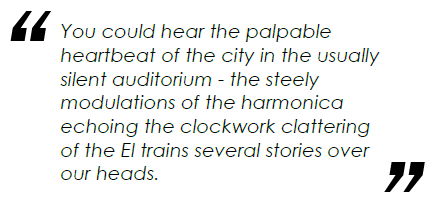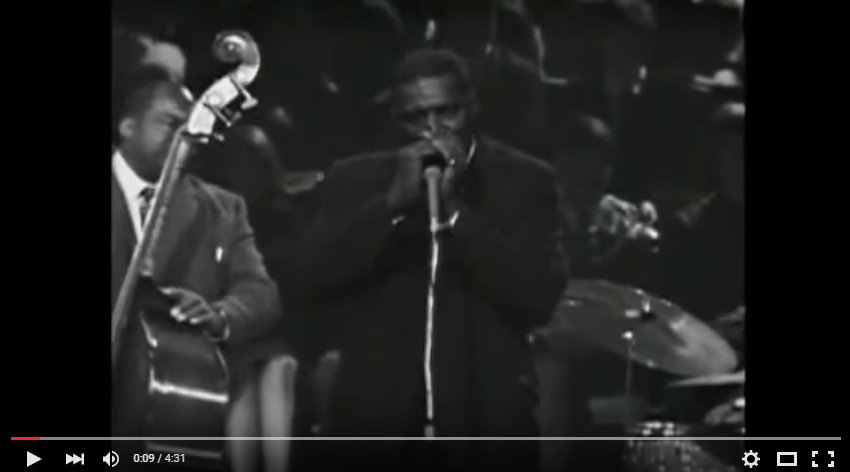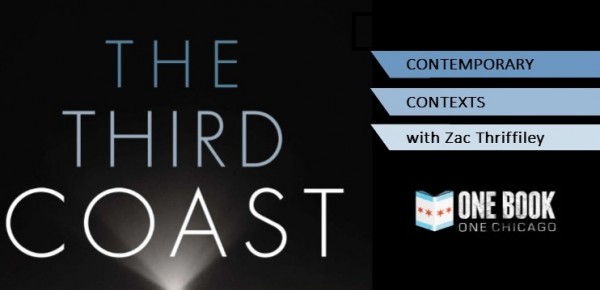As the Chicago Public Library’s One Book, One Chicago (OBOC) program kicks off this month with a series of events related to Thomas Dyja’s The Third Coast, this column seeks to find out what it is exactly that makes Chicago “the city that gives.” Using a critical lens of the city’s tumultuous past and its uncertain future, the articles released in the upcoming months will examine what it is that Chicago contributed to the national American identity fifty years ago and what contributions–for better or worse–it makes to this day.
“She [Still] Moves Me”: Chicago Blues at Midcentury and the Present Day
The Cindy Pritzker Auditorium at Harold Washington Library is a far cry from the blues clubs of Bronzeville and the West Side. Instead of cumulus clouds of cigarette smoke hanging from the ceiling, one looks up to find state-of-the-art theatrical lighting. Listeners sit thankfully in plush seat cushions instead of creaky barstools or high-top tables crammed together to fit as many paying customers as possible. Onstage, there is no upright piano, no extensive drum set, and no former Southern sharecroppers living paycheck to paycheck, struggling to get by on music and a prayer. Instead, there’s Paul Kaye, cradling a worn guitar in his lap, and Harmonica Hinds, a microphone in one hand and his namesake in the other. As out of place as the music of Muddy Waters and Howlin’ Wolf may seem in the lower level of a public library, this is where Kaye and Hinds have chosen to give a brief history of Chicago blues to an eager audience.

The hour-long concert held on October 22, a collaboration between the Old Town School of Folk Music and the Chicago Public Library, is part of a series of events sponsored by CPL’s One Book, One Chicago program, running through April of next year. This year’s selection, Thomas Dyja’s The Third Coast: When Chicago Built the American Dream, gives a cultural history of Chicago through the middle of the 20th century by relating the triumphs and struggles of the city’s key players in music, art, literature, architecture, and politics. A substantial amount of the text relates the story of how the thriving blues scene of  1950’s Bronzeville, the predominantly African-American neighborhood roughly situated between Cermak and Pershing, gave way to the rise of rock-and-roll near the end of the decade. Reading about music, however, is not the same as listening to music. With their performance Kaye and Hinds hoped to fill the sensuous gaps left in Dyja’s text – to provide an experience of Chicago blues firsthand.
1950’s Bronzeville, the predominantly African-American neighborhood roughly situated between Cermak and Pershing, gave way to the rise of rock-and-roll near the end of the decade. Reading about music, however, is not the same as listening to music. With their performance Kaye and Hinds hoped to fill the sensuous gaps left in Dyja’s text – to provide an experience of Chicago blues firsthand.
To hear Paul Kaye tell it, the blues was born in Chicago. Or, at least, the blues industry was born in Chicago, given that the city was home to numerous recording studios for a number of blues artists of the 1920’s and 30’s. Blind Blake, a poor Southerner who worked his way up the Midwest circuit to become the first studio musician for blues in Chicago, was, according to Kaye, essentially B.B. King a generation before B.B. King would begin recording on his own. However, The Third Coast gives a different picture of the blues scene in the 1950’s. The less popular acoustic guitars of Blind Blake and Big Bill Broonzy were rendered obsolete the moment Muddy Waters bought his first electric guitar and “re-created modern, industrial life with ears still startled by screeching El trains, police sirens, and factory whistles.” That loud, brash electric guitar and the wailing of a harmonica would become the elements of a distinct sound that separated Chicago blues artists from their Southern counterparts.
Sure enough, Kaye and Hinds gave a thrilling demonstration of this Chicago sound through several popular selections performed in the short time they were given. “She Moves Me,” a slow-and-steady but sexual hit by Muddy Waters, proved to be  a crowd favorite, but the climax of the afternoon came as Kaye and Hinds launched into an explosive rendition of Howlin’ Wolf’s “Smokestack Lightning.” As Kaye began plucking out the tune’s hypnotic unchanging melody, Harmonica Hinds released a falsetto howl to match the wailing cries of his instrument with only the stomping of his feet to keep time. The audience, many of its members old enough to have heard this song countless times at Zanzibar or the 708 Club, began clapping along. You could hear the palpable heartbeat of the city in the usually silent auditorium – the steely modulations of the harmonica echoing the clockwork clattering of the El trains several stories over our heads.
a crowd favorite, but the climax of the afternoon came as Kaye and Hinds launched into an explosive rendition of Howlin’ Wolf’s “Smokestack Lightning.” As Kaye began plucking out the tune’s hypnotic unchanging melody, Harmonica Hinds released a falsetto howl to match the wailing cries of his instrument with only the stomping of his feet to keep time. The audience, many of its members old enough to have heard this song countless times at Zanzibar or the 708 Club, began clapping along. You could hear the palpable heartbeat of the city in the usually silent auditorium – the steely modulations of the harmonica echoing the clockwork clattering of the El trains several stories over our heads.

Despite the popularity of blues through the middle of the century, the music never maintained a mainstream appeal with teenagers and young adults in the same way that Chuck Berry and rock-and-roll would in the years to follow. Dyja explains that the genre manages to survive today because, “the blues were enshrined as one of Chicago’s cultural institutions, but as a regional specialty to be preserved.” While Dyja’s description may liken blues to an exhibit in a museum, the music is not without its defenders and champions. Kaye and Hinds believe that this preservation has largely been successful. Popular blues clubs such as Buddy Guy’s Legends and Smoke Daddy are two of the last remaining mainstream locations to catch live blues music in the city, yet they still draw in crowds of locals and tourists alike weekend after weekend. Delmark and Alligator Records continue to produce blues records here in Chicago and, more impressively, return profits despite an ever-waning interest in the genre. Even Paul Kaye frequently gives classes on how to play blues guitar at the Old Town School of Folk Music, offering a new generation of musicians the opportunity to play their own part as curators of an influential piece of Chicago culture. Perhaps, fifty years from now, in a dim auditorium of a public library, Paul’s protégé will move an audience with as much skill and passion as he did.
-Zac Thriffiley, MAE
For more information on OBOC and for upcoming events around the city, visit their website here.
Or check out the Old Town School of Folk Music and find class registration here.
Special thanks to copy-editor Harry Breitner, BAE.
